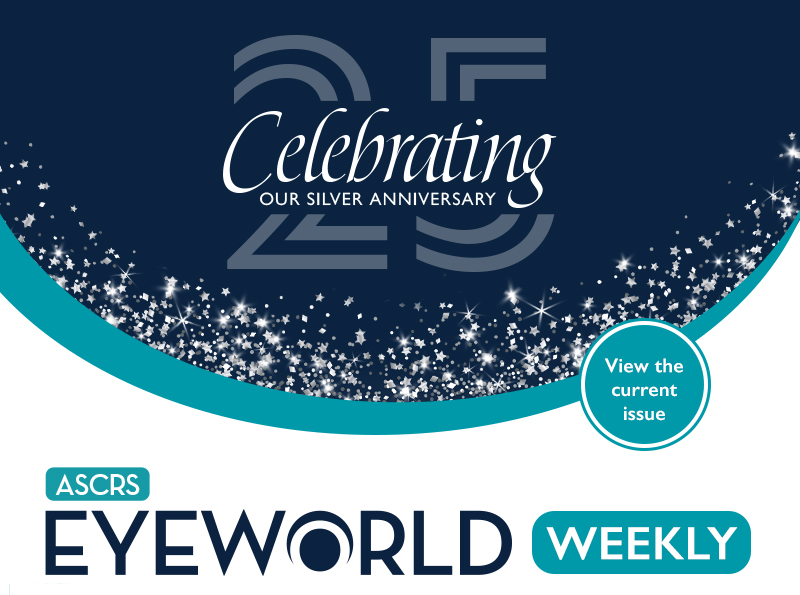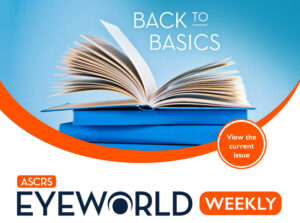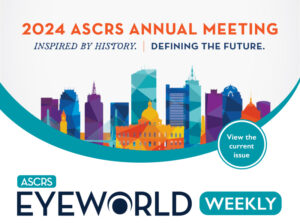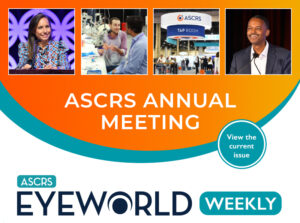
- Positive topline results from Phase 3 trial for first-in-class dry eye drop
- Study: Long-term efficacy of neuromyelitis optica spectrum disorder treatment
- Long-term data from gene therapy injection for wet AMD
- Positive data from Phase 1/2 trial of gene therapy for geographic atrophy
- Ophthalmic device company partners with augmented reality tech company
- ASCRS news and events
October 8, 2021 • Volume 27, Number 40
Positive topline results from Phase 3 trial for first-in-class dry eye drop
Bausch + Lomb announced positive topline data from its Phase 3 trial evaluating NOV03 (perfluorohexyloctane), which the company described as a first-in-class drop to treat signs and symptoms of dry eye associated with MGD with a novel mechanism. Both primary endpoints were met: There was a statistically significant change in corneal fluorescein staining from baseline to day 57 in the study group (treated 4 times daily with NOV03) compared to control (treated 4 times daily with placebo), as well as a statistically significant change in dryness score at day 57 compared to the control group. According to the company’s press release, the clinical program for NOV03 will conclude with the currently ongoing multicenter, open-label, single-arm, 12-month safety extension trial.
Study: Long-term efficacy of neuromyelitis optica spectrum disorder treatment
A study published in the Multiple Sclerosis Journal announced long-term safety and efficacy results for treatment of neuromyelitis optica spectrum disorder with UPLIZNA (inebilizumab, Horizon Therapeutics). Seventy-five participants who received inebilizumab treatment for up to 4 years were included in post-hoc analysis of the randomized controlled period of this open-label extension study. The study found that 18 attacks occurred in 13 participants during their treatment, for an annualized attack rate of 0.052 attacks per person per year. Twelve of these attacks occurred during the first year of treatment and two between years 2 and 4. There were two serious treatment-emergent adverse events related to the drug. The authors concluded that these results support the use of inebilizumab for treatment of neuromyelitis optica spectrum disorder, and its efficacy might be enhanced after the first year.
Long-term data from gene therapy injection for wet AMD
Adverum Biotechnologies announced long-term data from its OPTIC clinical trial of ADVM-022, a gene therapy for patients who would otherwise receive frequent anti-VEGF injections for wet AMD. Some patients who received this single gene therapy injection were followed for up to 2 years at this point, with the company reporting a more than 80% reduction in annual anti-VEGF injection frequency in patients who previously required frequent injections. According to the company’s press release, more than 50% of patients, after median follow-up of 1.7 years, were free of any supplemental anti-VEGF injections. Mean BCVA was also maintained over time, and retinal anatomy was maintained or improved.
Positive data from Phase 1/2 trial of gene therapy for geographic atrophy
Gyroscope Therapeutics announced positive data from its ongoing, open-label Phase 1/2 clinical trial investigating its one-time gene therapy, GT005, in patients with geographic atrophy secondary to AMD. The therapy has been well tolerated thus far in 28 patients, and biomarker data from 13 of these patients demonstrated sustained increase in vitreous complement factor I (CFI) compared to baseline in the majority of patients. The study also demonstrated sustained decreases in downstream proteins associated with complement system activation, the company’s press release reported. Gyroscope Therapeutics explained that an overactive complement system is thought to be a factor in AMD development, with CFI being a regulator of this system.
Ophthalmic device company partners with augmented reality tech company
BVI announced its investment and collaboration with Beyeonics Vision, a company developing integrated augmented reality, tracking, and image processing/AI platforms to enhance processes in the operating room. According to BVI’s press release, Beyeonics is creating Beyeonics One, a wearable ophthalmic digital imaging system to replace optical analog microscopes for an immersive, 3D viewing experience. BVI and Beyeonics will work together on commercialization of this product and potentially collaborate on other future innovations.
ASCRS news and events
- ASCRS Journal Club: Plan to join ASCRS’ interactive Journal Club on Thursday, October 14 from 9:00–10:00 p.m. ET for another session in this series where a panel of experts discuss two pre-selected manuscripts from the Journal of Cataract & Refractive Surgery (JCRS). Learn more.
- 2022 ASCRS Annual Meeting: Last call for submissions. The deadline for submissions for courses, papers, posters, and films, is October 14. Visit the Call for Submissions website for more information about the submission process.
- ASCRS Winter Symposium: Registration is open for the February 10–12, 2022, Winter Symposium in Park City, Utah. This meeting focuses on the innovative techniques and controversies in anterior segment ophthalmology and will also honor Alan Crandall, MD (1947–2020), former co-chair of this meeting, former ASCRS president, and a tireless teacher and humanitarian. Learn more.
- CME opportunity: “ASCRS Satellite CME: Supplemental Education to the ASCRS Annual Meeting” includes four, 1-hour programs captured from the 2021 Annual Meeting that are now available online and on-demand for viewing/claiming credit. Learn more.
Research highlights
- A case report published in the journal Cornea shared how the use of topical tea tree oil for blepharitis treatment could have unintended corneal effects. The case involved a 44-year-old male patient with a 1-year history of blepharitis that was not responsive to other eyelid hygiene treatment. He was treated with off-label, 50% topical tea tree oil and later presented with bilateral ocular discomfort. Slit lamp exam showed conjunctival injection and corneal epithelial defects in both eyes. He was treated with topical lubricants, an antibiotic, and steroid eye drops. He also used a bandage contact lens. The authors of the report note that eyecare providers need to be aware of this risk associated with tea tree oil and only use low-concentration, approved products.
- A study published in the British Journal of Ophthalmology is providing new insights on development of age-related cataracts. The study focused on protein stability changes that can occur with aging under physiological conditions, using novel equipment called Unchained Labs to evaluate thermal stability. According to the study, the melting temperature of rabbit lens proteins was lower in the younger age group compared to the older age group (67.8°C and 64.2°C, respectively). The authors also reported that crystallin may form more isomeric oligomers and may be more easily degraded in the older lenses. A higher solubility was observed after lanosterol was administered. The authors reported being the first to evaluate rabbit lens protein stability changes associated with aging by using biophysical methods under physiological conditions. The study confirmed that both structural stability and solubility of lens proteins decrease with age. The authors wrote that this study provides a cataract model for anti-cataract drug development.
Product news
- NIDEK launched its Retina Scan Duo 2, a combined OCT and fundus camera system.
- iCare USA announced FDA 510(k) approval of its EIDON Ultra-Widefield Lens.
This issue of EyeWorld Weekly was edited by Stacy Jablonski and Liz Hillman.
EyeWorld Weekly (ISSN 1089-0319), a digital publication of the American Society of Cataract and Refractive Surgery (ASCRS), is published every Friday, distributed by email, and posted live on Friday.
Medical Editors: Eric Donnenfeld, MD, Chief Medical Editor; Rosa Braga-Mele, MD, Cataract Editor; Clara Chan, MD, Cornea Editor; Nathan Radcliffe, MD, Glaucoma Editor; and Vance Thompson, MD, Refractive Editor
For sponsorship opportunities or membership information, contact: ASCRS • 12587 Fair Lakes Circle • Suite 348 • Fairfax, VA 22033 • Phone: 703-591-2220 • Fax: 703-591-0614 • Email: ascrs@ascrs.org
Mention of products or services in EyeWorld Weekly does not constitute an endorsement by ASCRS.
Click here to view our Legal Notice.
Copyright 2021, EyeWorld News Service, a division of ASCRSMedia. All rights reserved.



